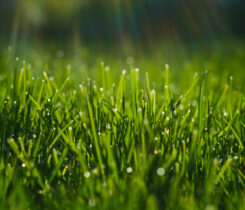Off the Record: On-site cultivar testing revisited

Mike Kenna
The USGA Green Section started testing new turfgrass cultivars on golf courses in the 1930s. Evaluating turfgrass performance at locations across the country is just as important today as it was in the past, and the Green Section helped support on-site testing by the National Turfgrass Evaluation Program (NTEP).
In 1939 and 1940, John Montieth Jr., Ph.D., and Fred V. Grau, Ph.D., established 40 “pie greens” throughout the country to identify the most desirable bentgrass varieties for putting greens. The experimental pie greens had 12 wedge-shaped sections, each planted with a different strain of bent. They were a regular or practice green to receive the everyday wear and tear of play.
Each green had standard strains for comparison, and the new entries were designated only by numbers to avoid possible partiality in scoring them. These trials selected popular vegetative bentgrasses such as Cohansey, Congressional and Toronto.
Most of the testing for new cultivars in the 1950s through the 1980s was on university experiment stations or commercial research plots. The NTEP started countrywide university turfgrass trials in the 1980s. A majority of the tests were at higher cutting heights more suitable for home lawns and commercial landscapes.
By the mid-1990s, the USGA Green Section saw a need to evaluate new bentgrass and bermudagrass cultivars on golf courses. Golf courses adopting the new grasses supported by the USGA research program were slow because they were not grown under real-world conditions.
Working with NTEP, the USGA supported 10 bentgrass and 10 bermudagrass putting green trials on golf courses.
Another aspect of the on-site testing was that the USGA provided help building the golf course test greens. Green Section agronomist Jim Moore worked closely with several golf course superintendents to build putting greens according to the USGA’s recommendations. So, the on-site tests provided an opportunity to demonstrate the revised putting green recommendations and information on new bentgrass and bermudagrass cultivars.
The lower cutting heights and foot traffic on putting green trials provided an excellent real-world evaluation of the new grasses. Joe Duich, Ph.D., Penn State University, had a breakthrough success with the A and G series of new creeping bentgrasses. TifEagle from Wayne Hanna, Ph.D., USDA-ARS, was among the best bermudagrasses. Also, Jim Moore was successful in demonstrating the new putting green recommendations.
Another positive outcome was the university trials started to maintain their putting green tests similar to area golf courses. The university trials and on-site testing correlated and helped superintendents have more confidence in university results. Other on-site tests, such as the overseeding trials in this issue of Golfdom, provided a significant contribution over the past 20 years.
I want to conclude with the following quote from the first on-site tests of the Green Section.
“It is difficult, however, to pass judgment on a strain of grass without comparing its behavior with that of other well-tested strains in adjacent plantings. In order to make such comparisons and to test promising strains under as many environmental conditions as possible, the Green Section has established at least one experimental green in almost every principal golfing section where bent can be grown.”
Words that are still true today lend importance to on-site tests, NTEP and other university trials around the country.
References
Staff. 2020. From The Vault: Experimental Greens. USGA Green Section Record. 58(6).
Staff. 1940. Experimental Greens. Timely Turf Topics. USGA Green Section. June 1940, p 2.
Steiniger, E.R., 1968. The Story of Cohansey. USGA Green Section Record. September 1968, pp 3-7.
Staff. 1944. Four-Year Summary of Ratings of Creeping Bents On Experimental Greens. Timely Turf Topics. USGA Green Section. June 1944, pp 2-5.












